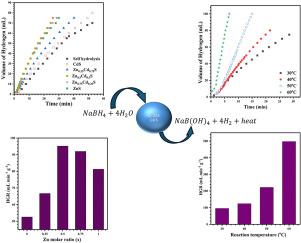Sonochemical synthesis of mesoporous ZnyCd1-yS quantum dots: Composition-dependent optical, electrical, dielectric, and hydrogen-generation characteristics
IF 4.3
3区 材料科学
Q2 CHEMISTRY, MULTIDISCIPLINARY
引用次数: 0
Abstract
Mesoporous ZnyCd1-yS quantum dots (QDs) with mixed cubic–hexagonal phases prepared by sonochemical technique at varying Zn content. Incorporating Zn ions in the CdS lattice reduced the crystalline size and enhanced the corresponding surface areas at increasing Zn contents. The increase of Zn content in ZnyCd1-yS QDs increased the bandgap from 2.52 eV to 3.83 eV and enhanced the corresponding Urbach energy from 72 meV to 279 meV. ZnyCd1-yS QDs exhibited small electrical activation energies ranging from 249 mV to 361 mV. The effect of Zn content on the catalytic activity of ZnyCd1-yS QDs toward hydrogen production through NaBH4 hydrolysis was investigated at different temperatures. Ternary alloys ZnCdS QDs exhibited higher catalytic activity than pure ZnS and CdS QDs, with Zn0·5Cd0·5S QDs displaying the highest hydrogen generation rate of 96 mL∙min−1 g−1. The increase of reaction temperature from 30 °C to 60 °C enhanced the rate constant of hydrogen production from 0.071 to 0.36 min−1. Based on the pseudo-first-order equation, the estimated apparent activation energy of Zn0·5Cd0·5S QDs was 45.3 kJ mol−1. Overall, the obtained results underscored the potential of ZnyCd1-yS QDs as promising catalysts for hydrogen generation.

介孔 ZnyCd1-yS 量子点的声化学合成:随组成变化的光学、电学、介电和氢气生成特性
利用声化学技术制备了不同锌含量的立方六方混合相介孔 ZnyCd1-yS 量子点(QDs)。在 CdS 晶格中加入 Zn 离子后,随着 Zn 含量的增加,晶体尺寸减小,相应的表面积增大。ZnyCd1-yS QDs 中锌含量的增加使带隙从 2.52 eV 增加到 3.83 eV,相应的厄巴赫能从 72 meV 增加到 279 meV。ZnyCd1-yS QDs 的电活化能很小,从 249 mV 到 361 mV 不等。在不同温度下,研究了锌含量对 ZnyCd1-yS QDs 通过 NaBH4 水解制氢的催化活性的影响。与纯 ZnS 和 CdS QDs 相比,三元合金 ZnCdS QDs 表现出更高的催化活性,其中 Zn0-5Cd0-5S QDs 的制氢率最高,达到 96 mL∙min-1 g-1。反应温度从 30 ℃ 升高到 60 ℃,制氢速率常数从 0.071 min-1 提高到 0.36 min-1。根据伪一阶方程,Zn0-5Cd0-5S QDs 的表观活化能估计为 45.3 kJ mol-1。总之,所获得的结果凸显了 ZnyCd1-yS QDs 作为制氢催化剂的潜力。
本文章由计算机程序翻译,如有差异,请以英文原文为准。
求助全文
约1分钟内获得全文
求助全文
来源期刊
CiteScore
7.80
自引率
2.50%
发文量
605
审稿时长
40 days
期刊介绍:
The Journal of Physics and Chemistry of Solids is a well-established international medium for publication of archival research in condensed matter and materials sciences. Areas of interest broadly include experimental and theoretical research on electronic, magnetic, spectroscopic and structural properties as well as the statistical mechanics and thermodynamics of materials. The focus is on gaining physical and chemical insight into the properties and potential applications of condensed matter systems.
Within the broad scope of the journal, beyond regular contributions, the editors have identified submissions in the following areas of physics and chemistry of solids to be of special current interest to the journal:
Low-dimensional systems
Exotic states of quantum electron matter including topological phases
Energy conversion and storage
Interfaces, nanoparticles and catalysts.

 求助内容:
求助内容: 应助结果提醒方式:
应助结果提醒方式:


